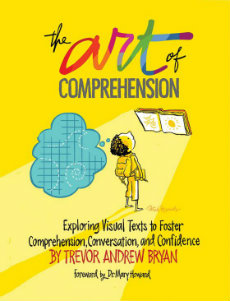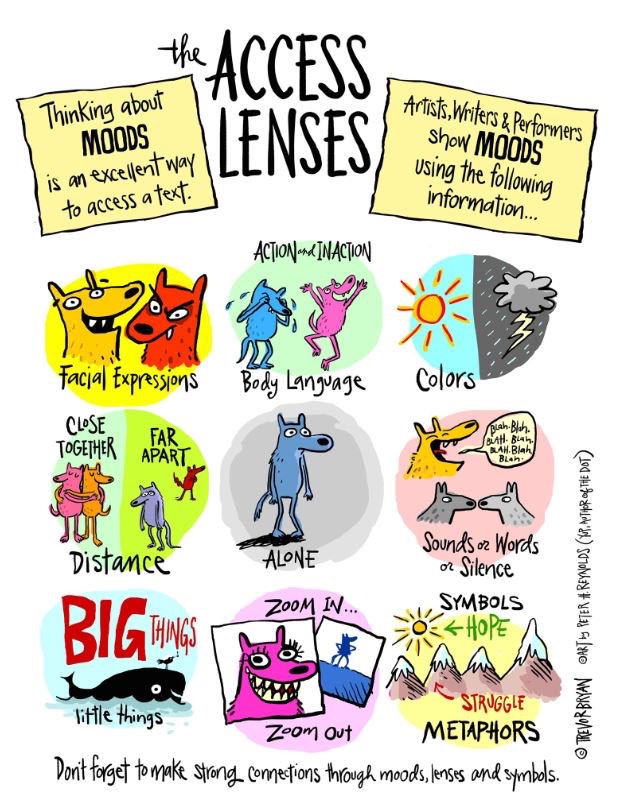Use Visual Texts to Help Reading Comprehension
The Art of Comprehension: Exploring Visual Texts to Foster Comprehension, Conversation and Confidence
By Trevor Andrew Bryan
(Stenhouse, 2019 – Learn more)

I’m an intermediate literacy coach, so part of my job is to read professional books and keep up to date on what’s out there.
I read a lot of books. Just ask the teachers I work with—I’m sure they must get a little tired of my book studies and endless emails with, “this book is amazing!” and, “you must have this book!” :-)
When I first read about The Art of Comprehension (AoC) on Twitter, my interest was piqued. When I received my review copy via MiddleWeb, I couldn’t put it down!!

I believe the mission of AoC can be summed up in this sentence on page 5:
“The Art of Comprehension outlines a simple way to begin to help students engage the sophisticated work that they have to do and sort through some of the cargo with a manageable and practical approach that is appropriate for all learners.”
Reaching all learners
One of the (many) things I love about AoC is how it relates to all learners! By utilizing visual texts, it provides a way for nonreaders and striving readers to participate in the same rich, authentic thinking tasks that their reading classmates are doing, even if they have difficulty with decoding the written word.
AoC has six chapters but basically three parts: the components that make up AoC (The Access Lenses, The Framework, and The Mood Structures); how to use the components while reading texts; and how students can use the components while writing their own texts.
There are nine Access Lenses that are tools Trevor Bryan describes as the “heart” of AoC. These tools allow students to become “active explorers and meaning makers” when interacting with texts. At the top of the Access Lenses page in the book (fig. 2.2), which is illustrated by Peter Reynolds, there are two boxes that give the gist of the Access Lenses: Thinking about MOODS is an excellent way to access a text, and Artists, Writers & Performers show MOODS using the following information…

That “information” is the nine lenses: facial expression; body language, action/inaction (bodies); colors; close together, far apart lens; alone; words or no words/sounds or silence; big things and little things; zooming in or out; symbols and metaphors.
The author states on page 15 under “The Magic of Mood” that:
…determining mood is the simplest, most straightforward way for our students, striving learners and nonreaders alike, to enter into most quality, good-fit text regardless of form or genre.”
The Framework is made up of six steps that help students move from simple conversations about texts to more sophisticated ones. It also provides a means for introducing and using the Access Lenses.
The Mood Structures can give students a better sense of where the story might logically go, once they get their bearings with the Access Lenses and the Framework. The Mood Structures are based on the idea of the story arc — they show a visual representation of how the mood of a story changes. Once students become familiar with the common mood structures of most stories, they can begin to make predictions and inferences when reading.
Improving comprehension and writing
The next part of the book shows how to teach students to use these components (the Access Lenses, The Framework and the Mood Structures) to improve their comprehension when reading. The final chapter is how to teach students to use these tools to improve their writing.
The book Is full of practical examples, book suggestions, vignettes of student work…it’s super easy to read but extremely hard to put down once you start!!
Taking AoC to class
I was not only able to read AoC, but I also had the opportunity to put it into practice with my 4th and 5th grade Language Arts summer school class. I knew I was excited about what these strategies could do, but it was even more exciting to see the students’ reactions using them!
Once, when doing a mood walk (pg. 61 in the book) through a picture book before I did a read aloud, students actually gasped aloud when the mood changed drastically from one page to the next! Then when I read the book aloud immediately after the mood walk, they said, “Oh! That’s why …”
We also used nonfiction texts with little to no picture support, and highlighted words that gave a positive or negative mood. This helped them think about the big idea of the text. It also promoted discussion between students when sharing our thoughts.
If you teach language arts, I highly recommend this book for your collection! I believe it will change the way you teach.
Pam Hamilton is an intermediate literacy coach in Middlebury, Indiana. She enjoys working alongside teachers as they instill a love of literacy in their students. She also enjoys being wife to Steve and mama to two beautiful daughters, Allie and Peyton.




























